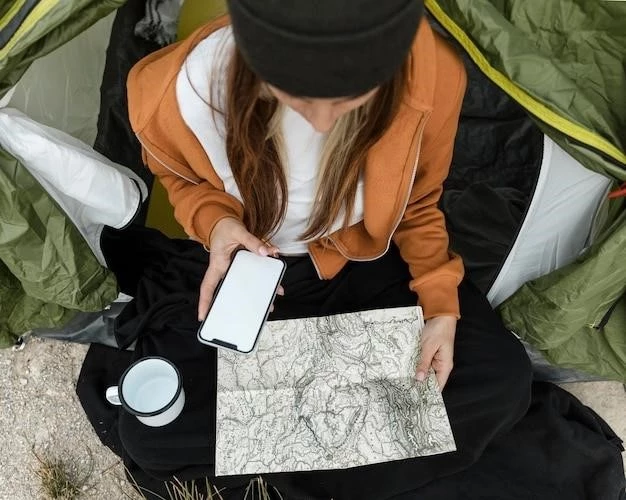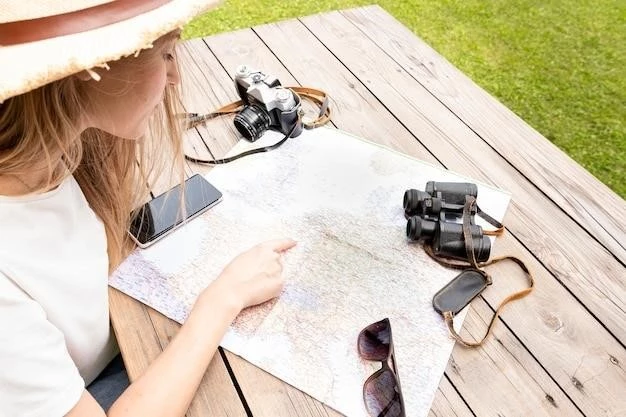Essential Preparations for Your 2024 Mountain Adventure
Embarking on a mountain adventure in 2024 requires meticulous planning and preparation․ A successful trip hinges on careful research‚ thorough packing‚ and a focus on safety․ Whether you’re drawn to challenging climbs‚ scenic trails‚ or the tranquility of nature‚ a well-structured plan ensures a smooth and unforgettable experience․
Research and Route Planning
Thorough research and meticulous route planning form the bedrock of a successful and enjoyable mountain adventure․ Before you set foot on the trail‚ invest ample time in understanding your chosen destination‚ potential hazards‚ and logistical considerations․ This proactive approach minimizes risks‚ maximizes enjoyment‚ and ensures you’re well-prepared for the challenges and triumphs that await․
Begin by identifying your objectives and desired experience․ Are you seeking challenging summits‚ leisurely trails‚ or opportunities for photography and wildlife viewing? Once you have a clear vision‚ delve into detailed research on your chosen mountain range or peak․ Utilize reliable online resources‚ guidebooks‚ and maps to gather information on trail conditions‚ elevation profiles‚ permit requirements‚ and potential hazards such as altitude sickness‚ wildlife encounters‚ or rapidly changing weather patterns․
When selecting your route‚ carefully consider your group’s experience level‚ fitness‚ and comfort with exposure․ Factor in daily mileage‚ elevation gain‚ and the availability of water sources and campsites․ It’s always advisable to choose a route that allows for flexibility and adjustments based on unforeseen circumstances․ Utilize online mapping tools and GPS apps to create a detailed itinerary‚ marking key waypoints‚ potential campsites‚ and emergency contact information․
Furthermore‚ research the accessibility of your chosen trailhead‚ including parking availability‚ shuttle services‚ and any necessary permits or reservations․ Inquire about local regulations‚ Leave No Trace principles‚ and any potential trail closures or restrictions․ Staying informed ensures a respectful and responsible approach to your mountain adventure․
Remember‚ thorough research and meticulous route planning are not merely logistical tasks but essential steps in ensuring a safe‚ enjoyable‚ and ultimately rewarding mountain experience․ By investing time in understanding your destination‚ you equip yourself with the knowledge and confidence to navigate the challenges and embrace the wonders of the alpine environment․

Gear and Equipment Checklist
Assembling the appropriate gear and equipment is paramount for a safe and successful mountain adventure․ The right gear provides protection from the elements‚ enhances your comfort‚ and equips you to handle unexpected situations․ A comprehensive checklist ensures you have everything you need to navigate the challenges and embrace the rewards of your journey․
Begin with the essentials: a sturdy and comfortable backpack‚ appropriate footwear (hiking boots or mountaineering boots depending on terrain)‚ moisture-wicking clothing layers‚ a waterproof and breathable outer shell‚ a warm hat and gloves‚ and sunglasses with UV protection․ These items form the foundation of your mountain wardrobe‚ providing comfort and protection from the elements․
Next‚ consider the specific demands of your chosen activity and environment․ For camping‚ a lightweight tent‚ sleeping bag rated for expected temperatures‚ a sleeping pad for insulation‚ a cooking system‚ and a water filtration method are essential․ If you’re venturing into technical terrain‚ add items like trekking poles‚ ice axes‚ crampons‚ ropes‚ and harnesses to your checklist‚ ensuring they are appropriate for your skill level and the intended route․
Navigation tools are crucial for staying on course and finding your way in unfamiliar terrain․ A detailed map‚ compass‚ and the knowledge to use them effectively are non-negotiable․ Consider supplementing these with a GPS device or smartphone app with offline maps for added reassurance and route-finding capabilities․
Don’t overlook essential safety and first-aid supplies․ A well-stocked first-aid kit‚ a headlamp or flashlight with extra batteries‚ a whistle for signaling‚ a fire starter‚ and a basic repair kit can prove invaluable in emergencies․ Pack sunscreen‚ lip balm‚ insect repellent‚ and a basic toiletry kit for personal hygiene and comfort․

Before your trip‚ thoroughly inspect all gear and equipment‚ making sure it’s in good working order and familiarizing yourself with its use․ Pack items systematically in your backpack‚ distributing weight evenly and ensuring easy access to frequently used items․ A well-organized pack enhances efficiency and minimizes the stress of searching for essentials on the trail․
Physical Fitness and Acclimatization
A safe and successful mountain adventure hinges on proper physical preparedness and a strategic approach to acclimatization‚ particularly when ascending to higher altitudes․ Adequate fitness minimizes the risk of injury and fatigue‚ enhances your enjoyment of the experience‚ and allows you to fully appreciate the challenges and rewards of the mountain environment․
Start your preparation well in advance of your trip by engaging in regular cardiovascular exercise‚ such as hiking‚ running‚ or cycling․ Focus on building endurance and strengthening the muscles used for hiking‚ particularly those in your legs‚ core‚ and back․ Gradually increase the intensity and duration of your workouts as your fitness improves‚ simulating the demands of your intended mountain route․
If your trip involves significant elevation gain‚ acclimatization becomes crucial to prevent altitude sickness․ Plan your itinerary to include gradual ascents‚ allowing your body time to adjust to the decreasing oxygen levels at higher altitudes․ A common strategy is to incorporate rest days or acclimatization hikes at progressively higher elevations․ This allows your body to produce more red blood cells‚ improving oxygen absorption and reducing the risk of altitude-related illnesses․

Stay well-hydrated by drinking plenty of water in the days leading up to and during your trip․ Avoid alcohol and caffeine‚ which can dehydrate you and exacerbate the effects of altitude․ Listen to your body’s signals‚ and ascend at a pace that allows you to acclimatize comfortably․ If you experience symptoms of altitude sickness‚ such as headache‚ nausea‚ or dizziness‚ descend to a lower altitude immediately and seek medical attention if necessary․
Remember‚ physical fitness and acclimatization are not merely boxes to tick but essential investments in your well-being and the success of your mountain adventure․ By preparing your body for the challenges ahead‚ you enhance your safety‚ optimize your performance‚ and unlock the full potential of your mountain experience․

Ensuring a Smooth Mountain Trip
Transitioning from meticulous planning to a seamless on-the-ground experience requires attention to essential logistics and safety protocols․ By prioritizing organization‚ communication‚ and responsible practices‚ you ensure a smoother and more enjoyable mountain adventure․
Packing Essentials for All Conditions
Packing for a mountain trip requires careful consideration of the often-unpredictable nature of mountain weather․ Layering is key‚ allowing you to adjust your clothing to fluctuating temperatures and activity levels․ Start with moisture-wicking base layers to keep sweat away from your skin‚ followed by insulating layers like fleece or down‚ and a waterproof and breathable outer shell for protection from wind and rain․
Footwear should be sturdy and comfortable‚ providing adequate ankle support and traction for varied terrain․ Hiking boots are generally suitable for most trails‚ while mountaineering boots are essential for technical climbs involving ice or snow․ Pack a pair of camp shoes or sandals for relaxing at camp and allowing your feet to breathe after a long day of hiking․
Protection from the sun’s intense rays at higher altitudes is crucial․ Pack a wide-brimmed hat‚ sunglasses with UV protection‚ and sunscreen with a high SPF; Don’t forget lip balm to prevent chapping․ Insects can also be a nuisance‚ so pack insect repellent containing DEET or picaridin for added protection․
Hydration is paramount in the mountains․ Carry a reusable water bottle or hydration reservoir with a capacity sufficient for your daily needs․ Water filtration or purification methods‚ such as tablets‚ drops‚ or a portable filter‚ are essential for treating water sources along the trail․
Pack nutritious‚ calorie-dense snacks to sustain your energy levels throughout the day․ Trail mix‚ energy bars‚ nuts‚ and dried fruit are excellent choices․ For multi-day trips‚ plan meals that are lightweight‚ easy to prepare‚ and provide ample sustenance․
Finally‚ pack a waterproof bag or dry sacks to protect essential items like electronics‚ maps‚ and first-aid supplies from moisture․ A headlamp or flashlight with extra batteries is indispensable for navigating around camp and handling unexpected nighttime situations․
Safety Considerations and Emergency Planning

Prioritizing safety is paramount for any mountain adventure․ The inherent unpredictability of mountain environments underscores the importance of preparedness‚ responsible decision-making‚ and a comprehensive emergency plan․
Before setting out‚ thoroughly research potential hazards specific to your chosen destination and time of year․ Familiarize yourself with local weather patterns‚ wildlife risks‚ and common mountaineering accidents․ Knowledge is key to anticipating challenges and responding effectively․
Always share your detailed itinerary with someone reliable‚ including planned routes‚ campsites‚ and expected return times․ This allows for timely assistance in case of unforeseen circumstances․ Consider carrying a satellite communication device for emergency contact in areas with limited or no cell phone reception․
Pack a comprehensive first-aid kit‚ including essential medications‚ bandages‚ blister treatments‚ and pain relievers․ Familiarize yourself with basic first-aid procedures and consider taking a wilderness first-aid course for enhanced preparedness․ Knowing how to handle common injuries and illnesses can be crucial in remote settings․
Mountain weather can change rapidly‚ so be prepared for all conditions․ Pack layers of clothing‚ rain gear‚ and extra food and water․ Learn to recognize signs of hypothermia and altitude sickness‚ and descend to a lower elevation immediately if symptoms occur․
Exercise caution when navigating uneven terrain‚ especially in areas with loose rocks or steep drop-offs․ Use trekking poles for added stability and balance․ Be aware of wildlife and maintain a safe distance from animals‚ even if they appear docile․
Remember‚ a safe mountain adventure is a combination of meticulous planning‚ informed decision-making‚ and a healthy respect for the power and unpredictability of nature․ By prioritizing safety considerations and developing a comprehensive emergency plan‚ you empower yourself to navigate challenges effectively and ensure a more enjoyable and memorable experience․
Leave No Trace Principles and Responsible Tourism
Venturing into the mountains is a privilege that comes with the responsibility to minimize our impact and preserve the pristine beauty of these natural environments for generations to come․ Embracing the seven principles of Leave No Trace ethics ensures a sustainable and respectful approach to mountain travel․
Plan Ahead and Prepare: Thorough research and meticulous planning are fundamental to responsible travel․ Choose trails appropriate for your group’s size and skill level‚ obtain necessary permits‚ and familiarize yourself with local regulations and Leave No Trace guidelines․
Travel and Camp on Durable Surfaces: Stick to established trails and campsites to minimize disturbance to vegetation and soil․ In pristine areas‚ disperse your campsite and avoid creating new fire rings or impacting delicate vegetation․
Dispose of Waste Properly: Pack out everything you pack in‚ including trash‚ food scraps‚ and hygiene products․ Use designated toilet facilities when available or follow proper backcountry sanitation practices․
Leave What You Find: Resist the urge to collect souvenirs or disturb natural and cultural artifacts․ Preserve the integrity of the environment by leaving rocks‚ plants‚ and historical objects undisturbed․
Minimize Campfire Impacts: Use established fire rings when available and keep fires small and manageable․ Burn only locally gathered firewood and ensure fires are completely extinguished before leaving your campsite․
Respect Wildlife: Observe wildlife from a distance and avoid approaching or feeding animals․ Store food and scented items securely to prevent attracting wildlife to your campsite․
Be Considerate of Other Visitors: Maintain a respectful distance from other hikers and campers․ Keep noise levels down‚ especially in the early morning and evening hours․ Yield to uphill hikers on the trail․
By adhering to these principles‚ we become stewards of the mountains‚ ensuring their pristine beauty and ecological integrity for generations to come․ Responsible tourism is not merely a set of guidelines but a commitment to preserving the very essence of the wilderness experience․










